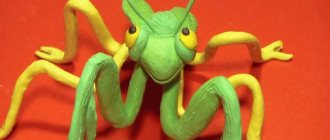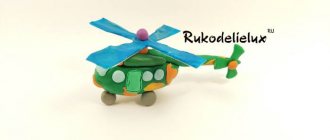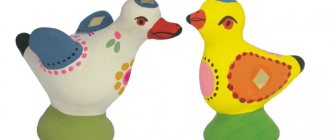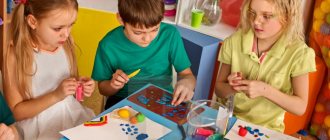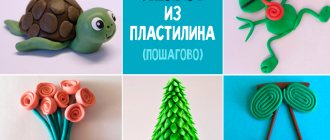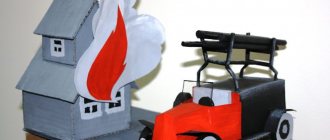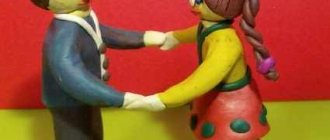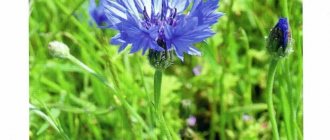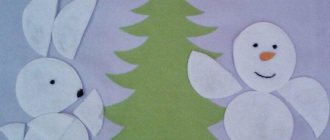In this article you will find many ideas for modeling from plasticine with step-by-step instructions and photos, as well as what crafts you can do with a child at different ages.
Working with plasticine has a beneficial effect on a child's development. These activities improve memory, attention, have a good effect on thinking, develop fine motor skills of the hands, which in turn contributes to the development of speech, form the imagination, open up creative abilities, and force one to exercise imagination. You will learn more about the benefits of practicing with plasticine and other materials in the article Let’s sculpt with children from plasticine. Plasticineography
Is plasticine necessary for children under one year old?
It is recommended that children engage in modeling from the age of 1; until the child is one year old, the child will most likely show no other interest in plasticine other than trying it out. But children are all different, so you can try modeling with your child earlier. Show your baby plasticine of one color, tear off a piece of it, roll the ball, let him hold it in his hands. If the child is not interested, put it aside and try again after a while.
For small children, it is best to use soft plasticine, for example, or better yet, prepare your own salt dough. Read about salt dough and crafts made from it in the article DIY salt dough crafts. Crafts for the holidays
Modeling from plasticine for children 2 and 3 years old
At the age of 2 to 3 years, a child still cannot cope with ordinary plasticine, so it is worth choosing special soft plasticine for small children.
Children are still learning to control their hands and it is difficult for them to practice modeling. Select tasks that are not difficult for your child so that he can cope with them; this will inspire him, give him self-confidence and he will want to continue to engage in this useful type of creativity.
By the age of three, a child will already be able to:
- tear off pieces from plasticine
- make balls out of them
- flatten them
- stick plasticine to paper and smear it
- crush the balls with your palms
- make sausages
- twist them into rings
- combine all the components into one craft.
The parents' task is to teach their child this.
Show your child
- how to cut a sausage and get rings
- how to cut out figures from flat cake
- how to cut dough into squares, triangles and other shapes
- how to stick various objects onto plasticine smeared on cardboard, for example, seeds, beads, cereals, pasta
The duration of a modeling lesson at the age of 1-3 years is 5-15 minutes and depends on the child’s mood and desire to work with plasticine.
For this age, it is recommended to use plasticine only in primary colors, so as not to overload the child with a large variety and not distract from the modeling activity itself. In addition, if desired, colors can be mixed and new shades can be obtained.
Types of materials for modeling
The baby products industry can offer modern parents a variety of products that can be used for modeling. A wide range of plastics includes both the material itself and play sets, which include molds, cutting tools and other related items.
Clay
The most ancient material for modeling. People learned to sculpt from clay even before the development of civilizations. This material is found everywhere, because it is a fine sedimentary rock. You can get it yourself, but it is much easier to buy it at a hardware store or art shop. To work, clay should be mixed with water and kneaded thoroughly - after this it acquires a viscous consistency.
After drying, the clay retains its shape. Unfortunately, it is impossible to produce ceramics—fired clay—at home; this requires a temperature of about 900° C. However, even products made from raw clay can be stored on a shelf for a long time, although they are fragile.
Lifehack. In order to imitate ceramic shine, the sculpted craft is treated with a layer of PVA glue. After drying, the product is covered with a film, which also improves mechanical strength.
True, clay is not suitable for small children - it intensively stains hands and everything around them, and in the process of evaporation of moisture it quickly hardens. But for boys and girls of school age, modeling with clay is already a serious creative process that introduces them to artistic culture.
Gypsum
This material is more suitable for casting rather than sculpting, allowing precise shapes to be achieved with low weight. However, even an infant can find it interesting and educational to leave prints in a trough with plaster.
Expert opinion
Mikhailova Alevtina Petrovna
Child development teacher
The advantage is that plaster products can be painted. The downside is that it dries very quickly.
In order to be able to sculpt with plaster by hand, it is better to purchase special dense sculptural plaster of a yellowish color - it is more flexible and takes longer to dry, but is not sold in construction stores.
Clay-based plasticine
One of the most famous materials of our time. Previously, plasticine was made from clay powder, to which wax, animal oils and powdered natural dyes were added.
Today, polymer compounds are used as additives to purified and bleached clay, which provide the composition with the necessary plasticity and allow it to retain its properties after a long time.
Classic plasticine based on clay (kaolin) is quite hard. Sometimes it is called “Soviet”, but here the difference is more in the composition than in the time of production. The fact is that at that time polymer compounds were not yet known in such quantities, and most importantly, they were not being introduced into the domestic sphere. Therefore, old-style plasticine has good adhesion within the mass and with foreign objects.
It is very dense, and therefore, before playing with it, an adult must knead and roll it out thoroughly. Only after this the kids will be able to sculpt something with their still weak hands.
The advantages of this material are its mechanical strength and adhesion. The man's head will definitely not fall off if it is connected well. The disadvantages are the need for preheating, as well as high soiling.
A well-known “Soviet” way to preserve freshly molded plasticine products is to place them in the freezer for a day. The object will become hard and, even after subsequent thawing, will not fall apart, but will become increasingly hard over time.
Polymer plasticine
Abroad, industrial technologies were used in folk goods as a means of making a profit. This is how polymer plasticine was invented - natural kaolin was replaced by plastic compounds with additives.
This made the material more flexible, homogeneous, and soft. During storage, it does not harden and requires almost no preheating. Its softness allows it to be used even by one-year-old children. Even if they don't make anything resembling the real thing, they can squish the clay in their hands and watch it change shape. It also develops the muscles of the fingers and hand well.
Polymer plasticine is not entirely safe for health. It will not cause acute poisoning, but can cause digestive upset. In addition, a child can simply choke on a large piece of plasticine or stick it up his nose. Therefore, up to 3 years of age, play only under parental supervision!
Today, polymer plasticine has many subtypes: ball, floating, wax and others. Thanks to special ingredients, the properties of plasticine can change: it can be lighter than water, become as sticky as possible, or, conversely, not stain your hands, table and clothes.
Modeling mass
And again polymers are in the service of humans for children's entertainment. Modeling mass differs from plasticine in that, after giving it a shape, it gradually hardens in air.
Depending on the composition, hardening can last up to half a day. All this time, changes can be made to the finished craft. True, the cost of a good mass is quite high. In addition, it is not reusable, which means you will have to buy it again and again.
Play dough
A material that has gained popularity quite recently. Play dough is so named because it resembles regular stiff dough made from flour. The famous Play-Doh brand says that their dough's main ingredients are flour, salt and water.
However, the full composition is kept secret. It is obvious that the outstanding characteristics of a mixture of natural products are given by the dyes and additives that prevent drying and preserve the product from spoilage.
The main feature of play dough is its low adhesiveness. By allowing the child to play with the dough, parents can be sure that the child will not get dirty himself or spoil the environment. Due to its natural composition, play dough is safe to swallow - up to certain limits, of course.
Expert opinion
Mikhailova Alevtina Petrovna
Child development teacher
Unfortunately, play dough has one major drawback - it dries out in the open air, so it should be kept in a tightly closed container.
Kinetic sand
You can also find the names “cosmic sand” because of the special properties compared to ordinary sand or “rainbow sand” because of the pigments, thanks to which the substance in jars and buckets acquires different colors.
Kinetic sand is specially selected fine quartz sand to which special polymer binders have been added.
They give the material special properties: being soft and “flowing” in a fluffed state, sand holds its shape well when compacted.
When compacted into molds, it leaves clear impressions that ordinary wet sand will never produce.
Sand is not called kinetic for nothing: the tactile sensations when playing with it have a calming effect.
Therefore, classes with him are recommended for children with mental disorders, hyperactive and nervous boys and girls. Little fidgets will be captivated by an exciting game for half an hour, or maybe more, giving adults the opportunity to get down to business.
The great advantage of “space” sand is its ability to retain its properties in the open air. Therefore, many parents, having filled the sandbox, no longer collect the plastic mass in a container or bucket.
However, with all the advantages, kinetic sand has its disadvantages or, more precisely, features:
- With long enough use, sand gradually absorbs moisture from children's palms, dirt and dust particles. After a few months of active play, it may begin to smell unpleasant and stick to your hands. This is a clear signal to completely replace the material, since it is impossible to clean it.
- The quality of sand greatly depends on the manufacturer. Considering that both unknown Chinese factories and venerable companies produce this product, one sample can retain its “silky” properties for months, while another begins to stick to your hands after just a couple of weeks of use.
In order for any modeling material to last longer, be more pleasant and functional, it is worth choosing products from trusted manufacturers. A higher price is a payment for the interest and health of the child over a long period of time.
Modeling from plasticine for children 4 and 5 years old
At the age of 4-5 years, a child already skillfully handles a modeling knife, his hands are already stronger and he can work with ordinary plasticine.
Children of this age know how to roll balls and sausages, and now it will be more interesting for them to make more complex and interesting crafts themselves.
Invite your child to make a mushroom meadow or forest lawn with bushes and trees around. Maybe the child will want to make something of his own, don’t interfere with this. On the contrary, this is good and fosters independence.
Also, the mother can sculpt one part of the composition, and the child another, then combine everything into one craft. This way the child will feel responsible for his part of the work.
A child at this age can sculpt simple figures of animals, plants, birds, and food for dolls.
You can begin to master the technique of plasticine printing with your child and make simple plasticine paintings and panels. Invite your child to add natural and waste materials to such paintings.
The time of working with plasticine is 10-20 minutes; if the child is very enthusiastic, it can be extended a little, depending on the child’s perseverance.
Modeling from plasticine for children 6 and 7 years old
You can use regular plasticine or buy different sets, for example, for modeling confectionery products. There are also kits with mass for modeling; they harden well in air and are preserved in the future.
At primary school age, children already know how to independently fantasize and bring their ideas to life. They sculpt more complex figures following step-by-step instructions.
Help your child make a picture from plasticine; he can already make more intricate drawings with a lot of small details, transitions of colors and different textures.
There is no need to limit the time for modeling at this age; let the child do as much as he wants and as much imagination and perseverance as he has.
Modeling with plasticine flagella
Children really like this technique because of its simplicity, and the result is a very original and relief picture.
Drawing with flagella is accessible even to kids. The process of rolling and carefully laying out plasticine flagella is an excellent exercise for a child’s fine motor skills.
To simplify the task, draw the outline of the future picture on a sheet of cardboard in advance and mark with a colored pencil where which color will be used. You can take any drawing or outline from a coloring book as a basis. To ensure that the flagella roll easily and the baby does not get tired, use heated plasticine.
How to make food for dolls from plasticine?
Soft plasticine is good for creating toy food. It will be boring for the baby to just make balls, but if they are used as decoration for a toy cake, it will be more interesting. You can make various cakes, pasta, sandwiches, pastries and much more with your child, as long as your imagination is enough. You don’t have to throw away the candy boxes, but make your own toy candies for them. Be sure to fit your doll food to the container they will eat it from.
For older children, you can combine the lesson with mathematics, divide the cake into equal parts and study fractions, feed guests and count how many cakes you need to prepare for them.
Below we give you several step-by-step instructions on how to make some food for dolls from plasticine.
Broccoli made from plasticine
Take plasticine in three different shades of green. From the lightest one, make a sausage leg for cabbage, divide it in a stack into several small branches. Take three pieces of plasticine of different shades and press them through a kitchen strainer, and you have broccoli florets. Connect these parts together.
Modeling sausages from plasticine
Prepare sausage-colored plasticine. Make a flat cake out of it, put white stripes on top. Roll the cake, roll it like a sausage between your palms and put it in the refrigerator for a while. You need to cut the sausage using sawing movements, not pushing.
Making ice cream from plasticine
Take a piece of sand-colored plasticine and stamp cells on it, like on waffles. Now make a cone and one or three balls, the same color as you want to make ice cream, you can take different colors. We stick the balls onto the cone to its base, and wrap it with our wafer cake. You can add jam on top by smearing two or three sausages crosswise on the balls, stick small multi-colored pieces and sprinkle with crumbs.
Modeling cheese from plasticine
The cheese is made from yellow plasticine with a small addition of orange. Make a cake, cut out a triangle and press holes in it, it is convenient to make large holes with the back of the pen, and small ones with a writing tip or pencil.
Making a cake from plasticine
Make several plasticine balls of different colors, it is better to take two brown ones for the chocolate layers of the sponge cake, two different berry colors and one of whatever color you want for the icing.
We make chocolate and berry cakes very simply, flatten the ball a little and roll it out into barrels to even them out.
We combine all the cakes into one cake and roll it sideways again to even out all the layers.
We take our icing ball and roll it out as thin as possible, wrap our entire cake in it, cut off the excess edges and smooth it out.
Now we make the cream: roll out the plasticine into a thin and long sausage, fold it in half and twist it. We spread it around the perimeter of our cake.
We cut the cake into pieces and use a toothpick or toothbrush to add porosity to our chocolate layers of the sponge cake. Each piece can also be decorated with fruit beads and topped with glaze.
Bread can be sculpted using sand-colored plasticine. To make a loaf, add toothpick prints to it diagonally.
How to make a watermelon from plasticine?
We take black plasticine and roll several thin sausages. We roll out the red plasticine into a not very thin oval-shaped cake. Place one sausage in the middle and fold the flatbread in half.
Add a couple more sausages and fold them again and repeat this several times. Finally, give it a round shape.
We wrap our watermelon in a white cake, and then in a green one, thus making a peel.
Add lighter colored green stripes.
And cut it. Look how ripe our watermelon turned out!
What you need for the craft
To practice sculpting you will need special tools:
- Modeling board.
- Plastic knife.
- The stack is regular and jagged.
- Toothpicks.
- Pen rod.
- Brush.
- Cardboard for compositions.
For making crafts, regular medium-density plasticine is suitable.
Modeling from plasticine for children 5-6 years old develops fine motor skills and speech
Required colors of plasticine for the presented master classes:
- “Tiger”: two bars of orange plasticine, a little white, black, pink and green;
- “Pizza”: red, burgundy, brown, beige, black, green.
- “Human head”: beige, brown, a little black, pink, blue and white.
- “Dragon”: bright colors of orange, yellow, green, and some black and white.
- “Dinosaur”: 2 bars of green plasticine, a little brown, black and white.
- Composition “Autumn”: gray, black, yellow, purple, blue, light blue, red, orange, beige, brown.
- Composition “Bullfinch”: blue or blue, white, black, red or pink, brown, green.
Modeling a bird from plasticine
Let's blind a parrot. Follow the step-by-step instructions below and you will have a beautiful and talkative bird.
- Take red, yellow, blue, white and black plasticine
- Make an oval body for a parrot from yellow plasticine
- Add a smaller red circle - this will be the head of our bird
- The wings will be blue, to do this, stick two droplets on the sides of the body
- Add a white breast to your parrot
- Make a yellow beak, stick on the eyes and make a crest from the cones
- Let's add another tail and use a stack to push through the grooves on the bird's chest and wings that resemble plumage
- All that remains is to attach the paws and the parrot is ready
This kind of cockerel can be made from plasticine.
This is how a penguin is made from plasticine.
Compositions for modeling with children in kindergarten on the theme of winter, autumn, spring
Modeling from plasticine for children 5-6 years old should contain compositions from different seasons. This allows children to learn, understand and remember the characteristics and differences of natural seasons.
Below are examples of autumn and winter compositions.
Composition “Autumn”
This master class will show you how to convey the mood and colors of late autumn:
- To depict a leaden sky, you need to mix dark and bright colors. To do this, we combine the following colors of plasticine: gray with black, yellow with purple, blue with black. You will also need a blue piece.
- Using our fingers, we begin to spread yellow-violet plasticine on the paper from the upper corner, and draw a blue stripe below.
- Above the blue color, smear a dirty yellow spot with your finger, stretching it in all directions like the meager rays of the sun.
- Fill the sky completely with a gray-black and blue-black mixture to represent looming clouds.
- Along the bottom of the sky, extend the blue stripe for contrast.
- For the ground, a mixture of brown, white and yellow plasticine is used. This mass must first be kneaded in your hands, then spread on the bottom of the cardboard.
- Completely fill the empty space with this mixture until the blue stripe appears.
- Sculpt dark brown branches and a flat tree trunk, as well as yellow and orange foliage.
- Stick branches and trunk as a tree on the left and a bush on the right. The branches should be inclined to the right, as if they were being bent by a strong wind.
- Stick yellow leaves on the branches and under the tree.
- Press down each leaf with a stack so that a stripe remains in the form of a vein.
- We add orange leaves to the bush, and also go over them in a stack.
- We sculpt additional details: brown stump, beige honey mushrooms, black birds.
- All of them are attached to the picture.
- Add rose hips to the bush.
The autumn composition is ready.
Composition “Bullfinch”
This master class on sculpting a bright three-dimensional composition of a bullfinch on a branch:
- Cover the cardboard with a thin layer of a mixture of white and blue or blue plasticine. Blue and white plasticine should not be mixed until completely homogeneous; it is necessary that marble stains and inclusions remain visible.
- Roll out a long sausage from a brown block, tapering towards one end and widening towards the other end.
- Prepare a lot of thin green threads from plasticine as spruce branch needles.
- Stick a brown branch approximately in the center of the picture, approximately diagonally.
- Next, fragments are torn off from the green threads, bent in half and attached to a branch as Christmas tree needles. This is the only long process in creating a composition.
- The entire branch must be filled with needles.
- You can add more branches below and above the main one, keeping in mind that the central part of the picture should be left for the bullfinch.
- To make a bird, you need to fashion 2 thick cakes: black for the body and red for the breast. Give them the desired shape.
- You will also need one gray wing with 4 thin white stripes.
- Fasten the torso to the chest and attach the wing to it.
- Attach a white eye circle with a black pupil and a triangular yellow beak to the head.
- Attach the bullfinch to the background above the branch.
- Make a brown foot and attach it to the bird and a spruce branch.
The winter composition is ready.
Modeling from plasticine is a good way for preschool children to usefully spend part of their free time.
Article design: Natalie Podolskaya
How to sculpt dinosaurs from plasticine?
- Take plasticine of any color, because you can make a dinosaur whatever you want
- Divide a piece of plasticine into three parts, one will go to the head, from the second we will sculpt the body, and the third will be divided into all other parts
- Divide one piece into three more parts, and one of them also into three
- From the two largest pieces we make the body and the head, to do this we roll them into sausages and stretch them out, connect them to each other and align the junction. What you should get is shown in diagram number 3
- Roll the two middle pieces into cylinders and stretch them out a little, flatten them from the bottom and top, leaving a thin “waist” - form the legs as shown in diagram 4
- Make sausages from small pieces - front legs
- Now assemble the figure from what is already ready and smooth out all the joints
- Roll a lot of small balls from the remaining piece of plasticine and stick them, pressing them on the sides, onto the dinosaur's crest.
- Make his eyes and don't forget about his eyelids
- Use a plasticine knife to cut the dinosaur's mouth and open it. Push down the nostrils with a toothpick, trim the paws a little
- Make teeth and claws for our figurine from white plasticine
You can also make such a dinosaur from a pine cone.
And here is another dinosaur - stegosaurus, one of the most popular among children.
If a child wants to make a predator dinosaur, invite him to make a Dimetrodon.
Step-by-step instructions for sculpting a mushroom - fly agaric
Making such a craft is very exciting.
You need to prepare the necessary materials and tools:
- plasticine in white, red and green colors;
- cutting stack or scissors;
- stack with a sharp end;
- stack for making small cuts.
The work is performed in the following sequence:
- You need to make balls of approximately the same size from plasticine of each color.
- Using a white ball, you need to prepare the mushroom stem. To do this, you need to make a shape that resembles the shape of an egg, making the top and bottom slightly flat.
- You need to roll out a thin strip from a green ball, make cuts on it using a stack to make grass, and place it below the previous workpiece.
- A mushroom cap is made from a red ball, then eyes and a smile are drawn on it using a stick with a sharp end.
- Balls of different diameters are made from white plasticine and then flattened. The resulting parts are attached to the cap.
- Now you need to connect the leg and the cap. Ready!
How to sculpt a pony from plasticine?
After watching the My little pony cartoon, your daughter will probably want to make the same pony. Let us help her with this.
- Take plasticine of the desired color, pink, purple, red and blue shades are perfect
- Roll a sausage of the chosen color - this will be the body of the pony
- Pull one side of the sausage up into a cone - this will be the neck
- Roll the ball and stretch it out a little, forming the face of a small horse
- Make droplets out of two small pieces and stick them to the top of the muzzle - these will be the ears
- Use a toothpick to press down the pony's nostrils and mouth.
- Roll four cones from plasticine of the main color, cut off a little plasticine diagonally from the narrow side with a special knife, this is where the legs will be attached to the body
- Tap the wide part of the cones on the board to create horse hooves
- Assemble your figurine. Smooth out the joints
- To make the mane and tail, roll several thin multi-colored sausages, connect them together and cut them, stick them to our pony, bend them a little, imitating the curves
- Don’t forget about the eyes, make them not round, but elongated, in the shape of a leaf
Our pony is ready!
You can make several small horses of different colors and you will have many cartoon characters to play with.
You can make a pony in another way, see step-by-step photos below.
Crafts from plasticine
Show your imagination and combine natural materials and plasticine in one craft. It will be unusual and interesting for the child.
Making a boat from plasticine and nutshells
- Prepare nut shells, plasticine, leaves from trees, small sticks
- Stick a ball of plasticine into a cleaned shell and place a mast on it - a small stick
- Place leaf sails on the mast and attach another plasticine ball on top
- Launch your boats into the water
Making a caterpillar from plasticine and chestnuts
- Cook some chestnuts
- Roll several colorful plasticine balls
- Connect the chestnuts, alternating them with plasticine, press them down so that they stick firmly
- Make eyes from white and black plasticine
- Add a red balloon nose and a sausage mouth
- Don’t forget about the horns, they can be made from pieces of a match, combined with plasticine with chestnuts
You can also make a hedgehog like this from chestnut peel and plasticine.
These are such cheerful multi-colored snails made of plasticine and chestnuts.
